Mercer Family of Tan House
The parish register of Great Harwood has survived from 1547, just nine years after the registers were first required to be made, and Mercers are recorded in the very first pages. Whalley and Padiham parish registers also record Mercers in these years, and the marriage of Alexander Mercer and Grace Mercer in 1561 shows that there were already distinct family groups in the area. Alexander and Grace were the ancestors of the family that resided at Tan House in Great Harwood, although it isn’t clear when the family first lived at Tan House.
If Alexander or Grace left a will they have not survived, therefore we don’t know anything about their lifestyle or how they made a living, the only clue about that is from the marriage of their daughter Elizabeth to Robert Squire in 1612. Robert Squire was the grandson of Sir Thomas Hesketh and his wife Alice, the son of their daughter Dorothy. We know this because Elizabeth and her family were mentioned in the wills of her brother Thomas and his wife Grace. The Squires lived at what is still known as Squires Farm. This marriage suggests that this Mercer family were well-off members of the yeomanry.
There are just two children listed as being the children of an Alexander Mercer in the years before 1600, John born in 1574 and Elizabeth born in 1579. At this time often only the name of the child was recorded at the baptism, but John and Elizabeth were both named as the children of Alexander. It is difficult without corroborating evidence to be certain of relationships when compiling a family history; at times it is possible to look at the evidence available and reach a possible conclusion, while bearing in mind this may change if new evidence comes to light. What is known for certain about Thomas Mercer, born sometime before 1580, is that he had a sister Elizabeth who married Robert Squire and that he named his first son Alexander – therefore it seems quite likely that he was also the son of Alexander and Grace. The line from Thomas Mercer and his wife Grace Sellers can be traced with confidence to the early twentieth century in the main line of descent, with just one or two slight conundrums, which will be noted.
Thomas and Grace Sellers married on 20 January 1596 at Great Harwood church. Thomas and Grace died within eighteen months of each other and both left a will and an inventory that named their children and other relatives. From these documents we know:
- Their oldest son was Alexander, probably born in 1597, who was married to Ellin with a daughter called Elizabeth, and other children who were not named.
- Their younger sons were John and Edward.
- Their daughter was Elizabeth who was married to Henry Riley and who had a daughter Grace and other children.
- The relationship to the Squire family, which was mentioned by both Thomas and Grace.
Although this family were later known to be ‘of Tan House’ and some of whom we know were tanners in the eighteenth-century there is no evidence of tanning in the inventories of Thomas or Grace. Thomas and Grace were comfortable by the standard of the times, with Thomas’s goods and chattels being assessed at £197 5s 10d. Most of this wealth was invested in farm stock, mainly cattle and sheep. The inventory lists items relating to the full range of cloth production:
- One pair of tenters (hooks on which cloth was stretched)
- Two paire of loomes and furniture for them
- One paire of Walker sheares (walking refers to the fulling process in which the cloth was pounded, originally by feet.)
- One warping wought and gige (warping wought for preparing yarn and gige = gige wheel raises nap of cloth)
- One Spinninge whele and one spoile wheele
- One shearebord (possibly board on which to cut the raised nap of the cloth)
- One hueinge tub (to dye the yarn)
- Four shearing hooks
Grace left her ‘purple yorne’ to her daughter and it is possible it had been dyed by Grace in the ‘hueinge tub’.
In the inventory of Thomas made in 1625 corn and hay are mentioned as being in ‘Whittlebarne’, and in ‘Whittlehouse’ there were ‘one arke, one chest and a paire of bedstocks’. Whittles was close to the border with Billington near Dean Brook, and in his will Thomas mentions that he has assigned one messuage and tenement to his second son John and it is possible that this is Whittles.
The years around 1623 – 1625 were difficult years with poor weather, bad harvests, famine and disease. Parishes in Lancashire reflect a rise in burials in these years, but in Great Harwood parish register entries were almost totally missing. Many marriages, births and deaths would have taken place, but were not recorded therefore it is particularly difficult to reach conclusions about relationships without any other sources. The Tan House Mercers are relatively easy to trace because many of them made wills and these have survived, and being tenants there are records relating to the lands they leased.
Alexander son of Thomas, born in 1597, made his will in 1669, the year in which he died. He calls himself a yeoman and names his surviving children: John, William, Edward and Elizabeth. The will is quite brief however, and there is no inventory, so it isn’t possible to make any conclusions about how Alexander made his living or where he lived from the will. He was said to be of the Upper Town in the parish register in 1626, and in 1660 when a tax known as the lay subsidy was levied Alexander is listed close to the Mercer family of Cowden, so it is likely that the family were living at least in the general area of Tan House at that date. In 1670, the year after Alexander died, a lease was taken on Tan House by William Mercer, who was probably the son of Alexander and born around 1624. The lease stated that the tenement was commonly called and known as ‘Mercer’s tenement of the Tann House’ and that it was held by William. This was probably a transfer of the lease to William after the death of his father and does seem to confirm that the family had been at Tan House for some time.
William died in 1687 and the administration documents and an inventory have survived. The administration document poses something of a puzzle: it states that an Edward Mercer was his brother-in-law, being the husband of William’s sister Jennet. No Jennet Mercer is recorded as being the child of Alexander and Ellin, but it is very possible she was born around the time of the Civil War when recording of events was patchy. Jennet died in 1709 and was said to be the wife of Edward and from Tan House.
John and Edward, also sons of Alexander, were in 1677 assigned a lease on lands in the Upper Town of Great Harwood. These lands were previously held by a John Hindle, and that he was most likely the father of Edward’s wife Grace Hindle whom he married in 1679. I can find no burial record for John, so he may have moved from the area or his death was not recorded, however Edward and his family maintained an interest in the Upper Town lands until after 1764. These lands were somewhat scattered around the town rather than being a compact holding, but the farm buildings were located at what is now known as Hindle Fold or Hindle Fold Lane. Surprisingly, if the family had been at Tan House for a while and it had been known as such for some years, Edward is the first member of this family whose occupation is given as a tanner.
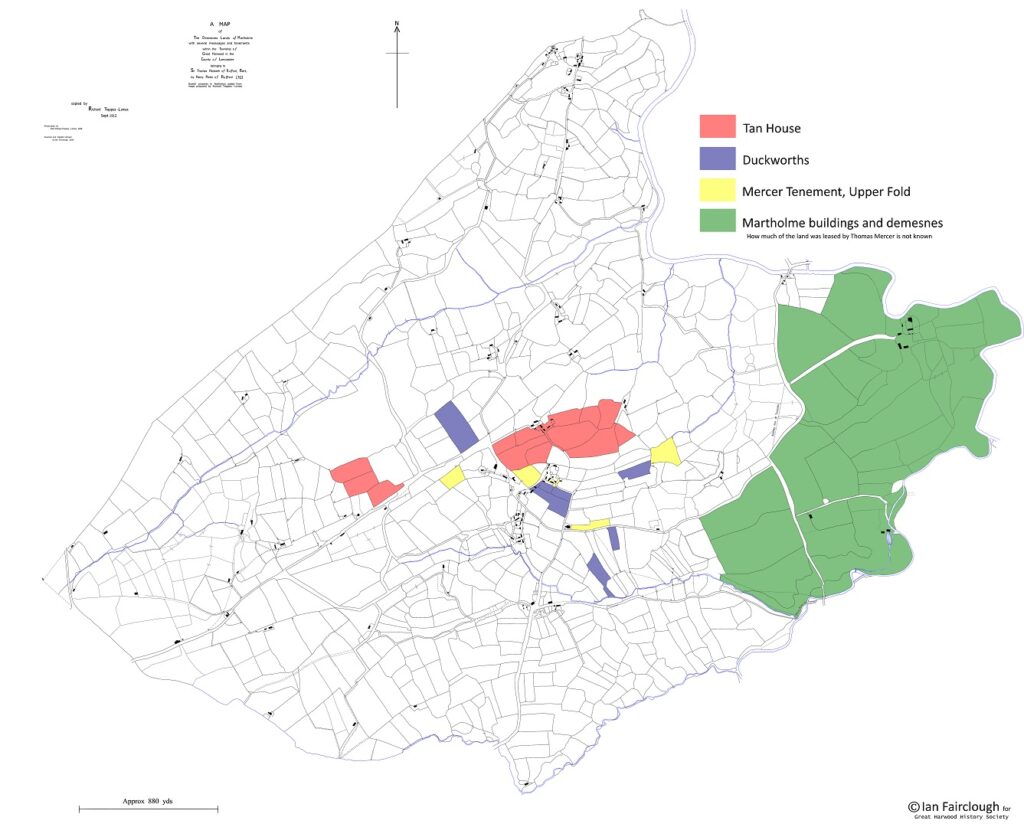
Plan of Great Harwood showing lands connected to Mercer family of Tan House.
Edward named four of his children in his will, Alexander, John, Grace and Ellen. Alexander first lived in Riley Hey in Great Harwood before moving to Rishton – his descendants are relatively easy to trace down to the will of his grandson Alexander Mercer in 1816. Grace married Robert Pickles, miller of Martholme Mill, and the couple later also moved to Rishton, to Holt Mill. It is difficult to know what became of John – there are many candidates and at least two burials in Rishton that could be for this John. Further research into Rishton records by those wishing to pursue this line may uncover the truth. Ellen, although she appears to have moved with her family to Rishton, remained the tenant of her father’s lands at Upper Fold, being mentioned as tenant in the Hesketh survey of 1735. She died in 1749 and a lease in 1764 confirmed that the land was still in the hands of the family but now held by Edward Pickles, son of her sister Grace.
The oldest son of Alexander and Ellin was Thomas, born in 1623 and it is from him that the main line of descent of the Tan House family continued. Thomas married Joanne Warburton at Burnley in 1649 and the marriage is recorded at both Burnley and Great Harwood churches. Although his children were born at the height of the Civil War their baptisms do seem to have been recorded, although not all were baptised at Great Harwood, some were baptised at Whalley and some at Church Kirk. When his son Edward was baptised at Church Kirk in 1662 Thomas was said to be a husbandman, which meant a farmer of leased lands rather than an agricultural worker, and the lands are named as Martholme.
Martholme was the manor house of the Hesketh portion of Great Harwood and the demesne farm. The Heskeths also had a manor house at Rufford; from the mid-1600s this became their main residence and Martholme was let out as a farm. It was the largest farm by far in the town; in 1765 it was about 261 customary acres. It isn’t clear how long Thomas was a tenant at Martholme, no lease appears to have survived, but his widow was still there in 1666 when a hearth tax was assessed. Two thirds of Martholme at this time belonged to the widow of Robert Hesketh, Lady Jane Houghton, but it was sequestered for her recusancy and let to a John Molyneux – he is listed as a tenant of part of Martholme and having two hearths while Joanne, widow of Thomas is shown as having three hearths. No will survives for Thomas, but an inventory was made at Martholme after he died. The inventory lists the rooms at Martholme that Thomas and his family inhabited, and they were:
- The boarden (?) roome: bedstocks and bedding
- The Citching Chamber: A room over the kitchen with beds, bedding and a spinning wheel
- The Brue House Chamber: A room over the brew house with beds, bedding and saddles
- The Farther larder: A chase bed and bedding
- The Nearer larder: Kitchen goods and seating – probably the living area of the tenancy.
The total of the inventory was £70 8s 1d.
Martholme in 1620 had twenty-four chambers, all listed on the inventory of goods made when Robert Hesketh died. It is thought that the house was reduced in size with the removal of the medieval hall shortly after this time.
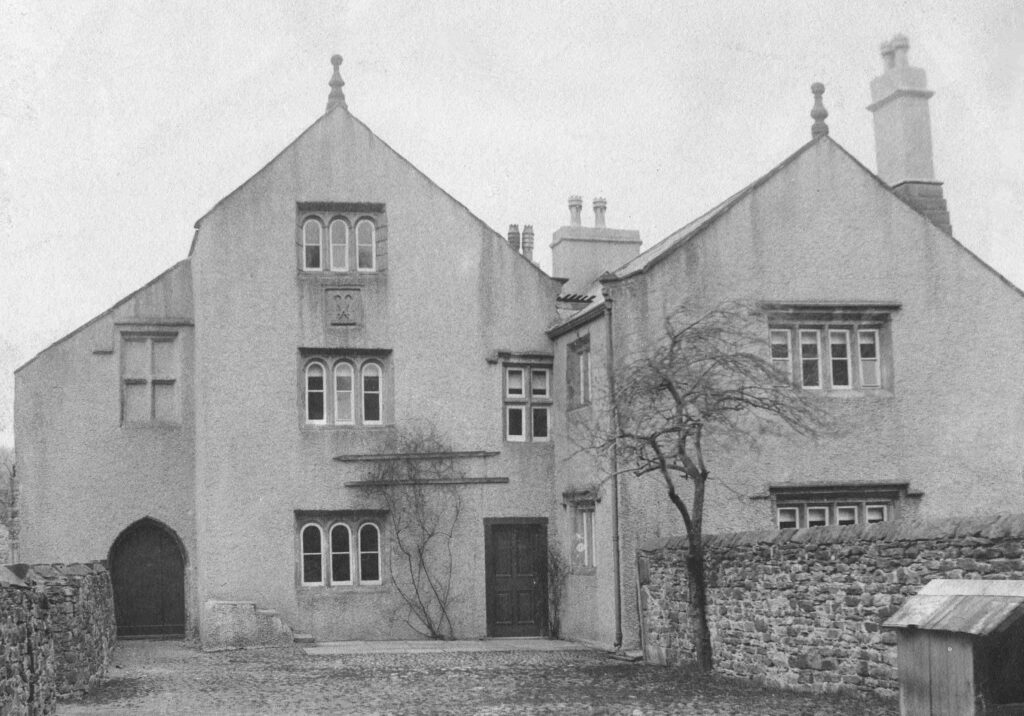
It is likely that some of the other baptisms recorded of children born to a Thomas Mercer around this time are the children of Thomas and Joanne, but it is difficult to be certain; the pedigree lists five children all of whom are either directly linked to Thomas in the registers or are mentioned in later records.
Alexander born in 1649 was the oldest child of Thomas and Joanne, and it seems that around 1687 when his uncle William Mercer died and the Tan House tenement would have then been vacant that Alexander may have taken the tenement at that time. A family called Turner (who later became major textile manufacturers) were at Martholme from at least 1687. I haven’t found a death for Joanne wife of Thomas, but there is a marriage in 1684 to a Lawrence Halliwell that could be Joanne. Although I have found no record of his marriage children are recorded as born to Alexander in the parish registers from 1686: Johanna 1686; Alexander 1687; Jane 1690; William 1694; Ellen 1692.
Catherine, Alexanders wife, died in March 1731 and Alexander made his will a short time later, although he didn’t die until February 1733. The will mentions his son Alexander, and daughters Jane and Ellin, both of whom were now married. Tan House isn’t mentioned in the will, but he left the lease of a tenement in the Lower Town known as Dugdalls to Alexander; it is clear though that Alexander was living at Tan House, he had married Ellen Bradeley in 1711 and the family were either listed as at Tan House or Upper Fold when most of their children were baptised, with the exception of Jenet born in 1723 at Mitton, which was where Ellen Bradeley originated.
A survey of the lands of Thomas Hesketh was made in 1735, after his death, and the lands and fields associated with all the tenements are listed. This is the entry for Tan House, although it isn’t named as such in the document:
Fields:
Higher broken up
Lower broken up
wood
Long field
Wallock meadow
Lower Earth
Lower Corn hey
Upper corn hey
Little ox hey
Great ox hey
Gold acres and Gold acre meadow
Scite barns Gardens and foulds
Size: 29a 0r 34p
For lives of:
Alexander Mercer 46
Anne Mercer sister 41
Alexander Mercer son 21
Alexander and Ellen had two sons and two daughters who survived to adulthood: Alexander born 1712, Thomas born 1718, Catherine born 1721 and Jenet born 1724. The older son, Alexander, died at a relatively young 43 in 1756 and his will has survived. In it he is named as a chapman of Blackburn, which at this time in this area meant a putter out of raw materials to workers to weave into cloth – a middleman and merchant. Alexander was the lessee of Duckworth’s tenement, although it isn’t clear how and when he came into the lease. Duckworth’s was in the Hindle Fold area, or as it was known at the time, Upper Fold. The lease for Duckworth’s was bequeathed to his brother Thomas, named as a tanner by Alexander.
Thomas had married Jane Boardman of Livesey in 1753 and they had nine children, seven of whom survived childhood. Thomas and Jane made their home at Tan House and are shown there in a lease on the property made in 1763:
Lower Tan House
30a 2r 17p
Thomas Mercer Tanner lessee.
Lives: Ellen daughter 8, Alexander son 4, William son 2.
Messuage called Tan House
Gold Acres
Meadow
Higher Gold Acres
The Wallock Meadow
The Long Field
The New Ox Heys
The 2 Corn Heys
The Lower Earth
The Higher Brokenup
The Lower Brokenup
Garden and waste
Close of common called Gold Acre Top
30a 2r 17p
The fields and size of the tenement have changed little since 1735.
Alexander, father of Thomas, died in 1766 and left lands in Lighthurst in Oswaldtwistle and Waterside in Bailey to Thomas. Thomas was directed to pay sums of money to his sisters Catherine, wife of William Shaw of Accrington, and Jennet, wife of Robert Charnley of Blackburn – both husbands were chapmen. All the rest of his estate he left to Thomas. No inventory of goods has survived for either Alexander or Thomas when he died in 1793 so their monetary worth isn’t known, but it is clear that by now the family were quite wealthy. Jane, wife of Thomas, seems to have been a member of the Boardman family of Livesey, although I have found no parish records or probate records to link her to a particular branch. However, the Boardmans erected Cherry Tree House in Livesey around 1800 and close to that is The Nook, where Thomas, the son of Thomas and Jane, opened a tannery and where the family lived from around 1840.
Thomas Mercer married Ellen Turner of Altham in 1804. Ellen was the daughter of Thomas Turner of Altham Hall; he was born at Martholme and William his brother and his family lived there until the early 1800s. The first child of Thomas and Ellen, named for her mother, was born a few months after their marriage; their second child, Thomas Turner Mercer, was born on 15 November 1805. Ellen died in 1810 and Thomas married Mary Bramley ten years later in 1820, but she too died, in 1829. Thomas himself died, at Tan House, in 1839.
The census year of 1841 shows Thomas Mercer living at Nook in Livesey, and listed as a farmer, although we know he was also a tanner. Listed also are wife Phebe (Bourne) and children Ellen, William, and Alexander. The Trappes-Lomax lease register DDLX 1/1 has payments for the rental of Tan House made from 1817 when this register began, made first by Alexander Mercer then by Thomas Mercer. They end in 1836.
Thomas Turner Mercer and his family prospered, both as tanners and cotton manufacturers but, except for their burials, their long connection to Great Harwood was at an end.
Grave No. 6 Plot 8 St Bartholomew’s Great Harwood
Alexander Mercer 1929
Anne Mercer 1874
Anne Mercer 1901
Elizabeth Mercer 1885
John Mercer 1879
Mary Mercer 1875
Mary Mercer 1896
Phebe Mercer 1878
Thomas Mercer 1866
Thomas Mercer 1907
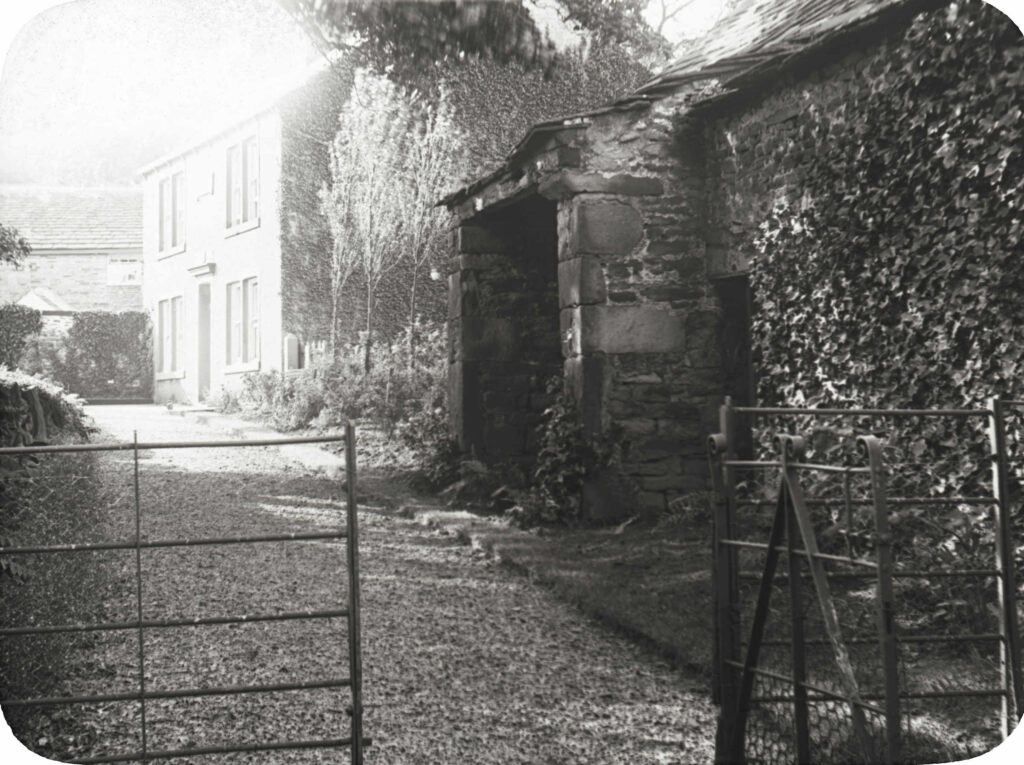
Mercer of Tan House Family Trees
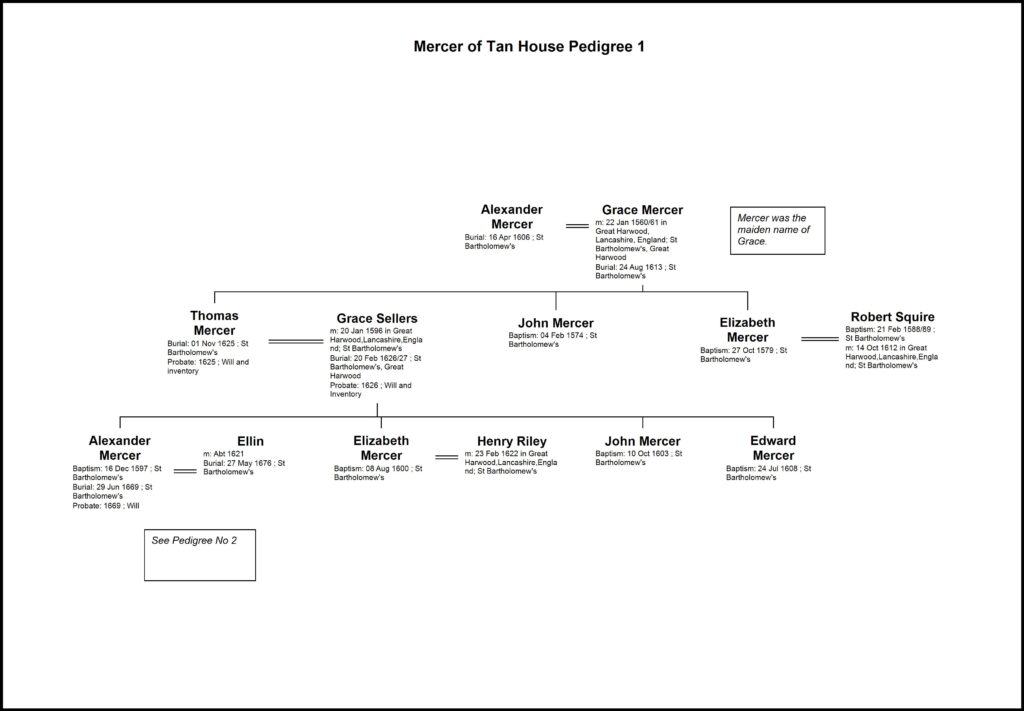
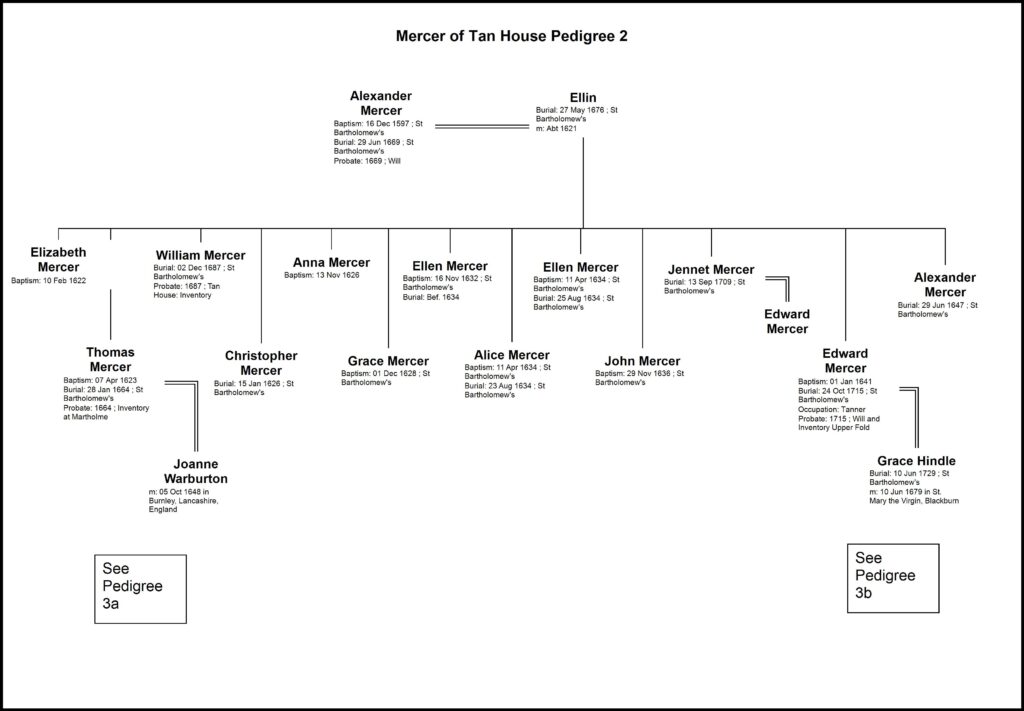
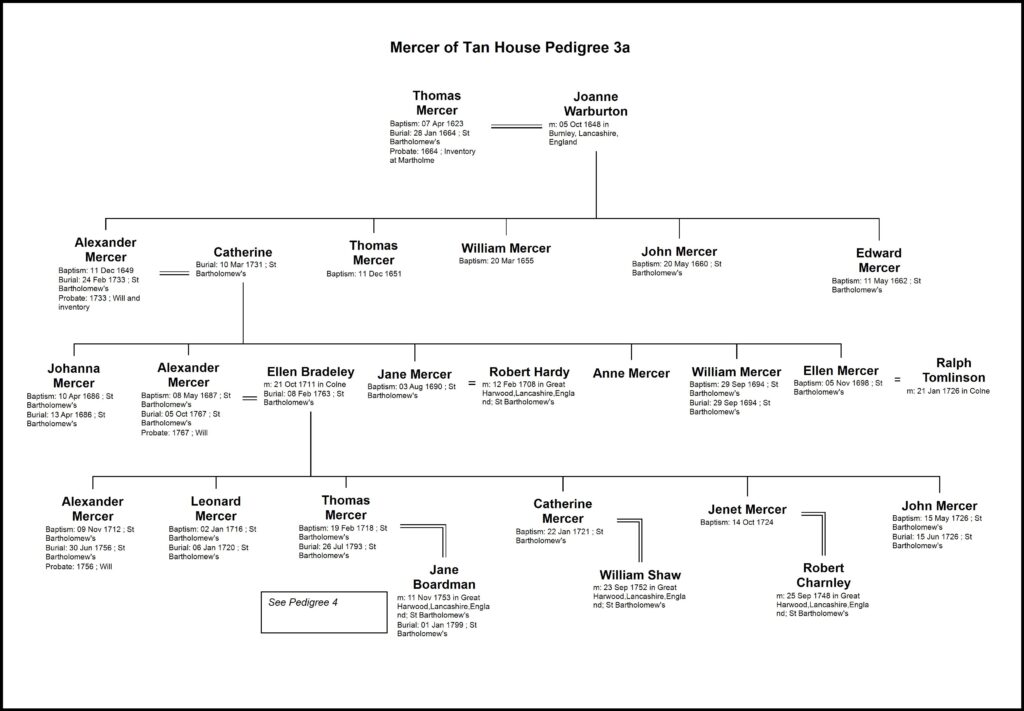
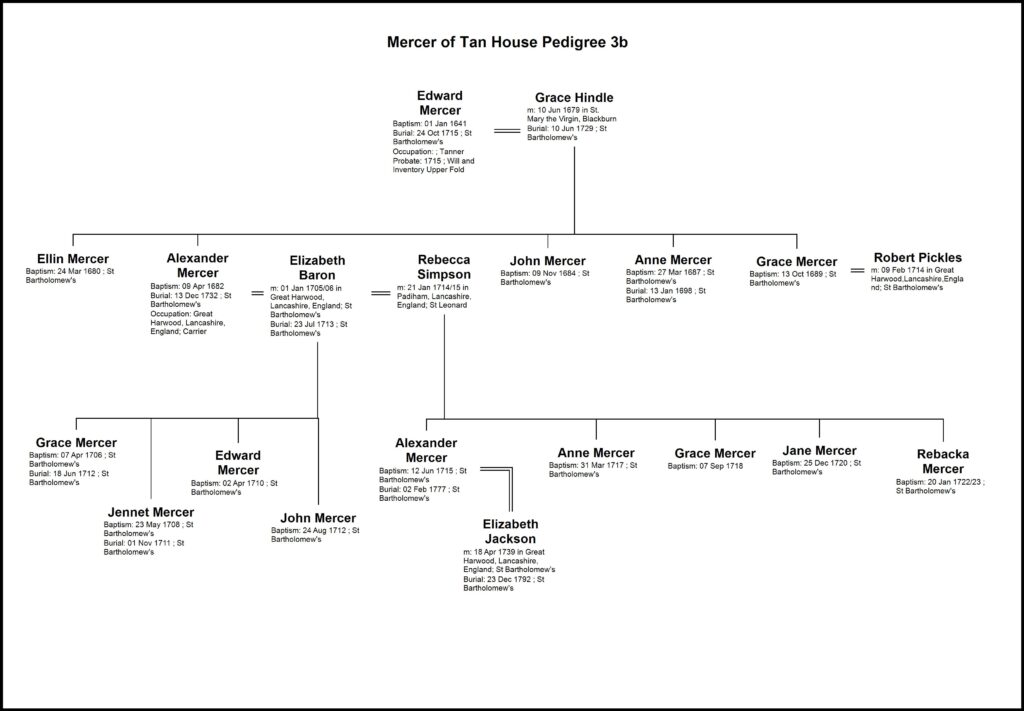

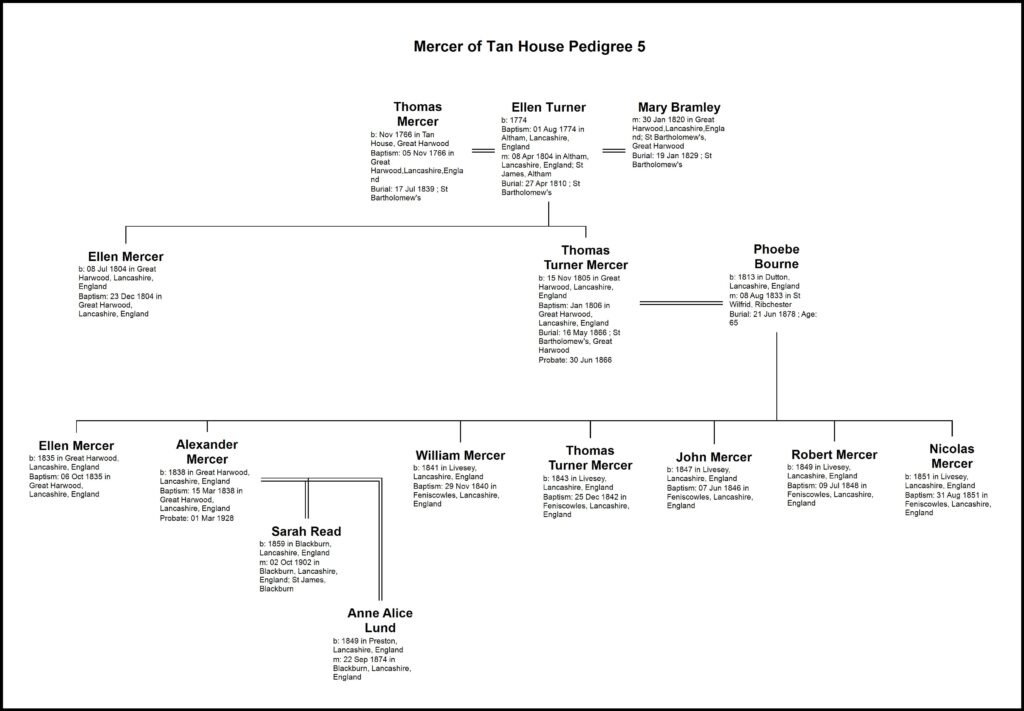
SOURCES AND CREDITS
Thanks are due to John Simpson for providing information about the Turner family of Martholme.
Thanks also to Ian Fairclough for the map of Mercer lands, based on a map held by JM Trappes-Lomax.
Links are included to transcriptions of material on this site.
| Survey of the Estates of Thomas Mercer c. 1735 | Manchester Archive L1/35/5 |
| Parish Registers of Great Harwood | Printed transcription and accessed from Ancestry.co.uk |
| Trappes-Lomax lease register | Lancashire Archive DDLX 1/1 |
| Lay Subsidy 1660 | Images from National Archives |
| Tan House lease 1670 | Lancashire Archive DDHE 18/49 |
| Field map of Great Harwood c 1763 | JM Trappes-Lomax |
| Trappes-Lomax Notebook of leases | Lancashire Archive DDLX 12/7 |
| Probate documents: | |
| Hesketh, Robert 1620 | Accessed at Family Search |
| Mercer, Alexander 1669 | Lancashire Archive |
| Mercer, Alexander 1733 | Lancashire Archive |
| Mercer, Alexander 1756 | Lancashire Archive |
| Mercer, Alexander 1766 | Lancashire Archive |
| Mercer, Alexander 1816 | Lancashire Archive |
| Mercer, Edward 1715 | Lancashire Archive |
| Mercer, Grace 1626 | Lancashire Archive |
| Mercer, Thomas 1625 | Lancashire Archive |
| Mercer, Thomas 1791 | Lancashire Archive |
| Mercer, Thomas 1664 | Accessed at Family Search |